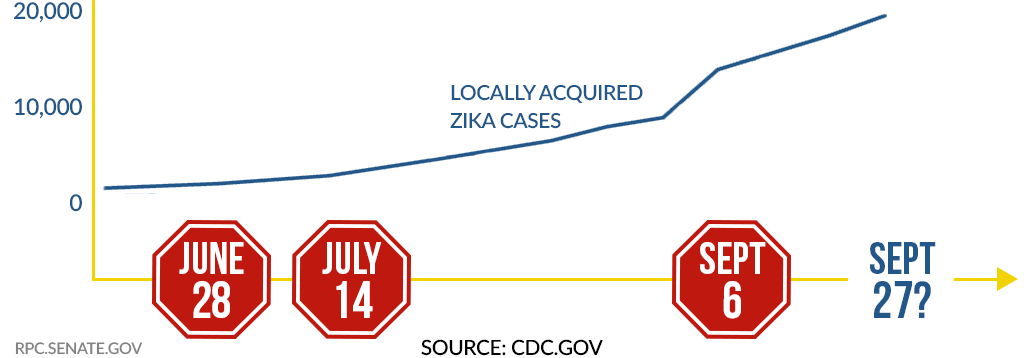A Clean Continuing Resolution
- The continuing resolution funds the government through December 9 at current levels.
- Zika is provided $1.1 billion in emergency funding.
- Flood relief is provided $500 million in disaster funding.
- There is $37 million in new funding for opioid adiction and recovery.
On Tuesday the Senate will vote on legislation that provides funding through December 9, 2016, at a rate equal to fiscal year 2016 funding – $1.067 trillion for base discretionary funding and $74.096 billion for “overseas contingency operations.”
Highlights
In addition to keeping the government running, the legislation includes the fiscal year 2017 Military Construction/Veterans Affairs appropriations bill which will provide full year funding to care for our nation’s veterans. With the passage of the Military Construction/Veterans Affairs bill, this will be the first appropriations bill passed by regular order since 2009.
It also provides $1.1 billion in emergency funding to combat the Zika virus. This is the same amount approved by the Senate 89-8 in May and included in the conference report repeatedly filibustered by Senate Democrats. Combined with funds already reprogrammed for Zika response activities, the total resources available to respond to the Zika virus are $1.7 billion. The bill includes Hyde restrictions, reiterating that no federal funds can be used for abortions. Like the House-passed conference agreement, no direct funding goes to Profamilias or any other Planned Parenthood affiliate. Senate Democrats have been filibustering Zika funding for 92 days, voting three times against funding.
Democrats block funding as Zika cases rise

The bill rescinds $400 million previously appropriated for certain health care programs in U.S. territories and in response to the Ebola outbreak and other emergencies. These funds are no longer needed for their previously intended purpose.
The bill continues funding all opioid-related programs at the Department of Health and Human Services and Department of Justice that were funded in fiscal year 2016, which totaled $320 million. The bill also includes $37 million in new funding to implement the Comprehensive Addiction and Recovery Act. This $37 million is the annualized level of funding for CARA’s new authorized programs, including a number of grant programs to combat substance abuse and overdose deaths, with a focus on heroin and prescription opioid abuse. The funding will allow the administration to begin implementing these programs during the period of the CR.
The Republican bill includes $37 million for CARA programs next year. Since the bill covers the next 10 weeks, about $7 million would be spent before Congress would have to act again.” – New Hampshire Union-Leader, “Fili-budgets: Avoiding the Shaheen shutdown”, 09-25-2016
The CR extends expiring authorities for FDA’s Rare Pediatric Disease Priority Review Voucher Program, which is set to expire at the end of this month. The program encourages the development of treatments for rare pediatric diseases. The CR also includes $500 million in disaster relief funding to HUD’s Community Development Block Grant program for major disasters declared in 2016, such as flooding in West Virginia, Louisiana, Texas, and Maryland. This amount is designated as disaster relief under budget rules.
The CR does not include the riders that were being discussed in negotiations with Democrats, such as language regarding the ICANN domain name transition, new programs for Flint water infrastructure, or adjustments to the Export-Import Bank.
Next Article Previous Article
